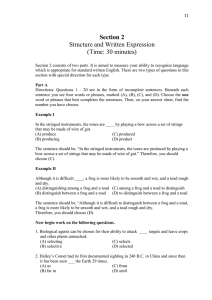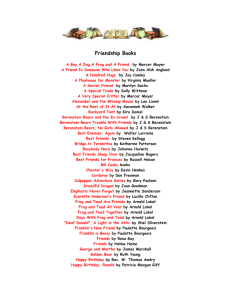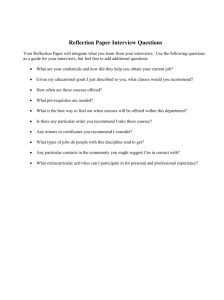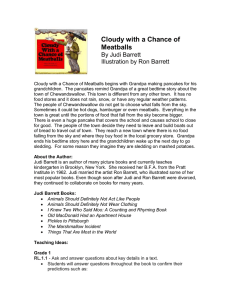literature project
advertisement
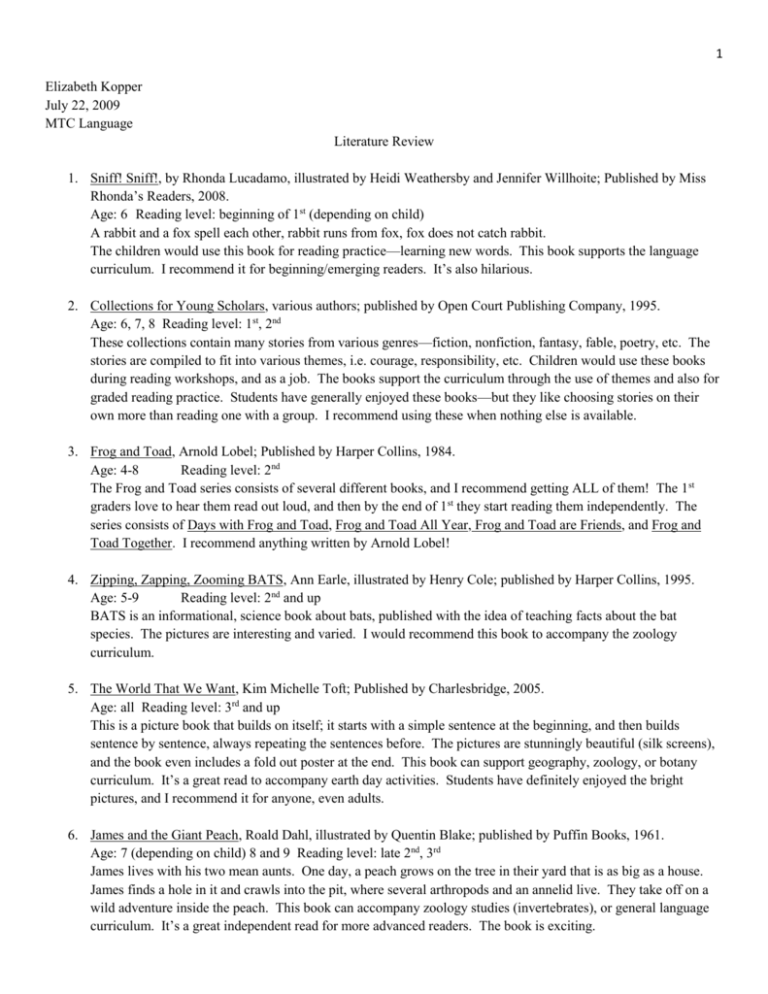
1 Elizabeth Kopper July 22, 2009 MTC Language Literature Review 1. Sniff! Sniff!, by Rhonda Lucadamo, illustrated by Heidi Weathersby and Jennifer Willhoite; Published by Miss Rhonda’s Readers, 2008. Age: 6 Reading level: beginning of 1st (depending on child) A rabbit and a fox spell each other, rabbit runs from fox, fox does not catch rabbit. The children would use this book for reading practice—learning new words. This book supports the language curriculum. I recommend it for beginning/emerging readers. It’s also hilarious. 2. Collections for Young Scholars, various authors; published by Open Court Publishing Company, 1995. Age: 6, 7, 8 Reading level: 1st, 2nd These collections contain many stories from various genres—fiction, nonfiction, fantasy, fable, poetry, etc. The stories are compiled to fit into various themes, i.e. courage, responsibility, etc. Children would use these books during reading workshops, and as a job. The books support the curriculum through the use of themes and also for graded reading practice. Students have generally enjoyed these books—but they like choosing stories on their own more than reading one with a group. I recommend using these when nothing else is available. 3. Frog and Toad, Arnold Lobel; Published by Harper Collins, 1984. Age: 4-8 Reading level: 2nd The Frog and Toad series consists of several different books, and I recommend getting ALL of them! The 1st graders love to hear them read out loud, and then by the end of 1st they start reading them independently. The series consists of Days with Frog and Toad, Frog and Toad All Year, Frog and Toad are Friends, and Frog and Toad Together. I recommend anything written by Arnold Lobel! 4. Zipping, Zapping, Zooming BATS, Ann Earle, illustrated by Henry Cole; published by Harper Collins, 1995. Age: 5-9 Reading level: 2nd and up BATS is an informational, science book about bats, published with the idea of teaching facts about the bat species. The pictures are interesting and varied. I would recommend this book to accompany the zoology curriculum. 5. The World That We Want, Kim Michelle Toft; Published by Charlesbridge, 2005. Age: all Reading level: 3rd and up This is a picture book that builds on itself; it starts with a simple sentence at the beginning, and then builds sentence by sentence, always repeating the sentences before. The pictures are stunningly beautiful (silk screens), and the book even includes a fold out poster at the end. This book can support geography, zoology, or botany curriculum. It’s a great read to accompany earth day activities. Students have definitely enjoyed the bright pictures, and I recommend it for anyone, even adults. 6. James and the Giant Peach, Roald Dahl, illustrated by Quentin Blake; published by Puffin Books, 1961. Age: 7 (depending on child) 8 and 9 Reading level: late 2nd, 3rd James lives with his two mean aunts. One day, a peach grows on the tree in their yard that is as big as a house. James finds a hole in it and crawls into the pit, where several arthropods and an annelid live. They take off on a wild adventure inside the peach. This book can accompany zoology studies (invertebrates), or general language curriculum. It’s a great independent read for more advanced readers. The book is exciting. 2 7. The Story of Dr. Doolittle, Hugh Lofting, illustrated by Michael Hague; Published by William Morrow and Company, 1997. Original publishing was in 1920. Age: All Reading level: 6th The story follows the adventures of a kind-hearted doctor, who is fond of animals and understands their languages. He travels to Africa on a boat with a bunch of his animals to cure the monkeys of a terrible sickness. While he is in Africa, he finds the “pushmepullyou.” This book can accompany zoology studies, since it is full of animals. It can also go with geography and the study of Africa. Students loved listening to this book and looking at the intricate watercolor pictures. I definitely recommend this as a read-aloud. 8. Echoes of the Elders: The Stories and Paintings of Chief Lelooska, by Chief Lelooska; published by DK Publishing, 1997. Age: all Reading level: 3rd This book is comprised of several folk tales from the tribes of natives in the Northwest. Several of them are suspenseful and scary, which draws the students in. My students, ranging from kindergarten all the way through third, have been captivated by these stories. They would go well with the history curriculum, when the students are learning about oral cultures and traditions. 9. The Lorax, Dr. Seuss; Published by Random House books for Young Readers, 1971. Age: 4-8 Reading level: 2nd, 3rd The Lorax speaks for the Truffula trees, which are all cut down by the Once-ler, who is greedy to make money from the sale of the trees. This book accompanies botany curriculum, and is well loved by the students. 10. The Story of Ferdinand, Munro Leaf, illustrated by Robert Lawson; Published by Viking Juvenile, 1936. Age: 6, 7, 8 Reading level: late 1st, 2nd Ferdinand is a bull. He is unlike other bulls because he enjoys sitting under his favorite cork tree all day and smelling the flowers. Other bulls like to jump around and butt their heads together. When the bull fight comes to Madrid, Ferdinand is picked by the matadors because he just happens to sit on a bee who stings him. He jumps around wildly and the matadors choose him for the fight. Students LOVE this story! It’s all in black and white, and it’s told very simply. It’s a great book to accompany peace lessons or zoology when learning about mammals.
